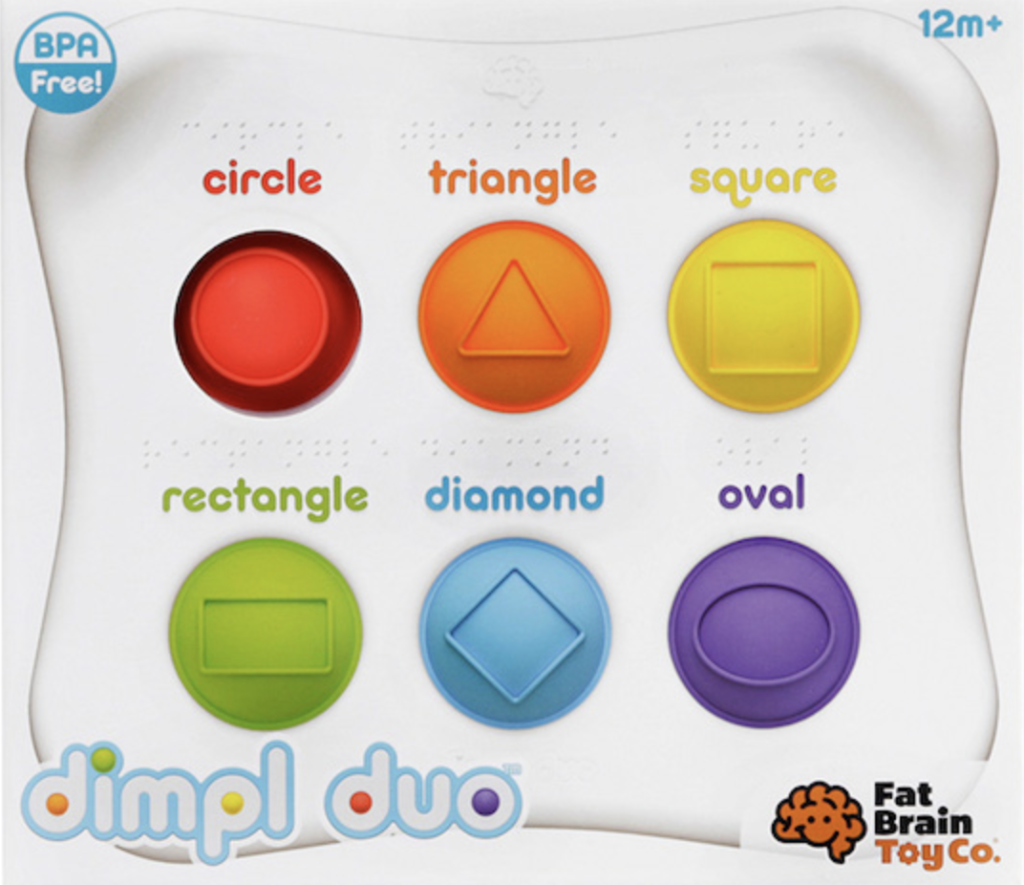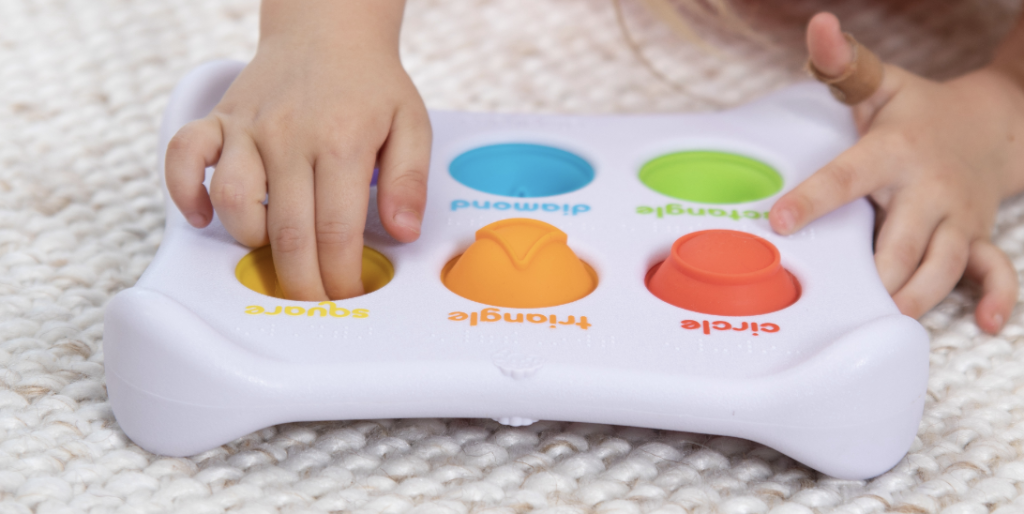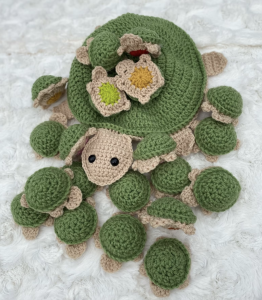I am obsessed with this shape toy I saw in the gift shop at the Science Museum of Minnesota last week.


Seen from above in the first photo, the triangle looks like a triangle. Seen obliquely, we notice that the triangle is embossed on a half-sphere, and so the sides of the “triangle” are actually curved. In what sense is this a triangle? In what sense is it not?
Opportunities for deep math for small children (whether intentional or not!) is always exciting for me. Some readers will complain about the diamond, but long-time readers will know my contrarian views on this matter.
This toy manufactures—Fat Brain Toy Co.—also makes the Shape Factory, which I am also obsessed with. I reached out a while back, got a promise to answer my questions, but never got any answers. So if you know anybody over there, ping them for me please! I’m still curious!
All this mathy fun got me thinking that I’d love to see what my online community thinks about when they think mathy gifts. So I put out calls on Twitter, BlueSky, and the newsletter. I encouraged folks to think broadly about “math” and also about “gifts”, and you all came through beautifully.
A few notes…
- I asked for email addresses to reduce spam responses because I was sharing a Google form on social media.
- I neglected to ask for names on that Google form, so all quotes and testimonials are anonymous.
- I asked for non-Amazon links. I encourage you to support the resulting diversity of sources.
- I verified that all the the links work during the week of November 20, 2023.
- Gift ideas are mostly listed according to the youngest age group our recommenders suggested. I encourage you to look at gifts in categories both older and younger than your intended recipient.
- Except for the links that direct to the Talking Math with Your Kids store, these links are not sponsored or otherwise remunerative for me.
And here we go.
Babies and toddlers (2 and under)
Both the Shape Factory and the Dimpl Duo (which I think of as Baby’s First Non-Euclidean Geometry Toy) are lovely for the little ones.
This wooden number puzzle is beautiful and has “No distracting colors or images; just chunky numerals.” The Artisanal Hexagons Puzzle has colors (hopefully not distracting!) and also mathy goodness for caregivers on the back.
Dot stickers! One submission reads, “We use dot stickers like EVERY DAY. Dot stickers to outline a figure, to graph something, to measure. We use regular packs of stickers to do matching games.”
And of course, what baby wouldn’t look amazing in an “I heart hexagons” onesie? No baby wouldn’t! Which is to say all babies would! Plus, no caregiver can resist talking shapes with a baby in a hexagon-themed onesie.
2–3 year olds
Tiny Polka Dot from our friends at Math for Love received this testimonial: “An amazing grow with your kids game. My daughter has been playing since she was 3. She is now 6 and I love all the different ways to play. Her number sense is amazing.”
Wooden trains and tracks, such as this amazing Brio set. Our submitter recommends not gluing the tracks down. “There are a variety of pieces and ways that they may or may not connect. Other people can play on what you build and more than one or two can play together if you have enough.” If you happen to have a fabulous train store locally such as Choo-Choo Bob’s here in Minnesota, you can probably find a starter or off-brand kit for quite a bit less than the one linked above. Also, these are timeless and durable toys so you probably know someone with some trains or tracks to spare from an earlier childhood phase. A word to the wise: the “name trains” you’ll find on Etsy and elsewhere are super cute, but have much less play value than the ones that look like actual train cars.
Are you crafty? This pattern for a turtle memory game is possibly the most adorable thing in this gift list.

4–8 year olds
At this age group, we got categories. In particular, folks had lots of books and lots of games to recommend.
Books!
- Friends Beyond Measure by Lalena Fisher. “A wonderful example of how math can help us explain the world around us; [supporting readers through] something that many children experience…a friend moving away.”
- The Dragon Curve by Alicia Burdess. “Give with a long strip of dry-wall tape so readers can fold along.” (Note: This one only seems to be available from Amazon. If readers know a non-Amazon source, get in touch please!)
- Everyone Can Learn Math and Let’s Explore Math by Alice Aspinwall. “Wonderful books that encourage the learning of math. Fun for all ages!”
- Spaghetti and Meatballs for All! by Marilyn Burns. “A very fun story about rearranging the seating for a big family meal.” And while we’re talking Marilyn Burns, I’ll add favorites from my own childhood, which are still in print. The I Hate Mathematics Book and Math for Smarty Pants.
- Sometimes We Do by Omo Moses continues the math and meals theme. This lovely book is full of playful family warmth (and math).
- Which One Doesn’t Belong? and How Many? by me. Leave a note at checkout if you want a signature or other inscription.
Games!
- Rolly Poly is loved by 3–7 year old nephews!
- Qwirkle is “a fun way to develop shape and color awareness as well as strategies with younger [children]”. Plus, I have it on good authority that you can make some pretty nice Which One Doesn’t Belong? sets with the Qwirkle pieces.
- Kanoodle is a “kid-tested part of a visual/spatial lab”.
- Hanabi is an “intricate, cooperative card game with pretty simple rules.”
- Ono 99 Game: “A fairly quick fun game whole family can enjoy, adding within a total of 99 and subtracting 10.”
- Shut the Box is “Fun for all ages! Love it for a quick game and easy to bring along when we travel. Easy to pick up and understand directions.”
- Swish from ThinkFun—makers of Rush Hour, What’s Gnu and others—is a “fun game that promotes visual/spatial recognition. Can play with 2 or more people, or even solo.
Other
- Magnetic Creative Math Sticks “make fun creative pictures. Easy for on the go and travel.”
- Pattern Blocks and Boards are “amazing toys as a child gets to explore the different shapes and how they could be used to form larger pictures/shapes. My 2.5 year grandaugther independently discovered that 2 trapezoids make a hexagon. So an excellent math gift for 3 -5 year olds.”
- 21st Century Pattern Blocks and Upscale Pattern Blocks are more recent updates and riffs on the Pattern Blocks theme. (Disclosure: I designed 21st Century Pattern Blocks, and licensed them to Math for Love. Buying and sharing 21st Century Pattern Blocks helps keep the math flowing and the laser cutter running!)
- This Magnetic Tangram Puzzle Play Set is “perfect for travel. Love that it is magnetic. Easy for kids to do on their own.”
- Although I contest whether pyramid should be in the name of this next item, a reader recommends the Magical Pyramid Arranging Game as being “great for making patterns. Love that it is a toy that can be as simple or as challenging as you want.”
- Puzzle A Day has been a semi-regular part of my Twitter feed for a couple years now, it seems. “It’s addictive! And easily accessible by kids and adults.”
- Sphinx Tiles are “:”Self-similar shapes, that give rise to some interesting explorations.”
- Mondrian Blocks. “The connections between art and math are extensive, and this game provides an opportunity to build/flex spatial reasoning and artistic practices at the same time.” Are your creations mathart or artmath? Who knows? Does it matter?
- Origami! Maybe a book like Easy Origami and some nice origami paper? Origami “combines creativeness, 3D shapes, following directions and engineering, many ages including adults can enjoy it .”
- Graph paper you design and print yourself! A reader says, “I found it today when looking for a way to create graph paper for my daughter to decorate/play with. It has many different types of graph paper, and you can configure the line weight (dark/light), sizing, etc. Easy to print. A good base for decorating / making patterns.”
- Tiling turtles now come with a super cute canvas storage bag.
9-12 year olds, teens, and adults
A reader’s son loves Skyjo. The Game is a “fun, relatively simple co-op card game with interesting levels of strategy to uncover under the surface.” Baba Is You is an “all-time great puzzle game where the main mechanic is that you can change the rules of the puzzle. Deceptively challenging and AWESOME to solve with others.”
Prime Climb. Classic, and a fun, low-floor, high-ceiling game. Portal and Portal 2 are the “most fun puzzle game(s) ever…I love this game so so much.” Turing Tumble is an “engaging screen-free way to promote logical/sequencial thinking.” Lok consists of “incredibly clever logic puzzles that ramp up in difficulty and complexity very smoothly. [The] paper and pencil version is awesome to work on with someone!” Charty Party. “Interpreting functions is not as hard as it seems and when you play a game it sneaks in math.”
Dice from The Dice Lab. They have a wide range of “fun shaped and sized dice. Very mathy. Much fun.” They also have these things, billed as “five-sided dice” which truly call into question what side even means.

A little while back, I worked with Amy Alznauer and Venkat Gopalan to develop Kolam Tiles. Like the Mondrian Blocks mentioned earlier, these also straddle the mathart/artmath line. “One rule. Infinite possibilities.”
Adults
We only had one recommendation just for adults. Jewelry from Hanusa Design that is “both beautiful and mathematical”.
